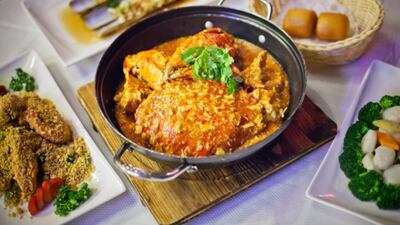Ning Yan’s interview for a prestigious position at the National University of Singapore in 2012 included the traditional group dinner for such occasions – a plate of sauce-smothered chili crab. He left after the meal with more than a full belly and a messy shirt.
“At that moment, I realised how much shelled waste there was in the region,” said Yan, now an associate professor at the university. “I’ve always wanted to start a project to make value out of large quantities of waste.”
Crab and shrimp shells, while smelly nuisances in the garbage, are composed of valuable building blocks for a $1.9 billion (Dh66.1bn) industry providing feedstock to sectors from agriculture to biomedicine. The problem is, breaking them down has typically required caustic chemicals that are harmful if released into the environment.
Mr Yan is part of a niche movement of firms and researchers trying to find cleaner ways to convert seafood shells into chitin and its refined cousin chitosan, a type of sugar with antibacterial and anti-fungal properties that can be used in wound dressings, cataract surgery, food supplements and a host of other applications.
Indeed, demand for chitosan is expected to grow at about 11 per cent per year through to 2030, according to Nandini Roy, a food and beverage lead at London-based business analysis firm Future Market Insights.
The substance is typically made by soaking the shells in hydrochloric acid and hydrogen peroxide, Ms Roy said. It’s cheap, but the chitosan it produces doesn’t work well for sensitive applications like biomedicine. Other researchers are trying to extract the substance using bacteria and enzymes.
Mr Yan uses a simpler two-step method. First the cleaned shells are ground down and immersed in pure water heated to 180 degrees Celsius under pressure to remove proteins that make the shells hard. Then carbon dioxide is dissolved into the water to form a weak acid that removes unwanted minerals, yielding the chitin once the liquid dries away.
The so-called biomass fractionation process takes hours to complete, and cuts the amount of CO2 emissions by nearly 95 per cent compared with the chemical extraction method, Mr Yan said.
While such methods may work in the laboratory, they’ve so far been too expensive or difficult to scale to compete with other natural polymers that can do the same job, Ms Roy said. “There is a long way to go for such bio-friendly methods,” she said. “They will be in the research phase for likely the next five years.”
Mr Yan is undeterred. He’s in the middle of the global shellfish industry – about 90 per cent of the world’s shrimp, crab and lobsters, 8.4 million tons worth, came from Asia in 2018, mostly from China and Indonesia, according to the Food and Agriculture Organisation. And he’s ready to test his method in volume.
Mr Yan said he’s in talks with a subsidiary of a global chemical company to build a facility in Vietnam that would commercialise his team’s method. Vietnam is the world’s third-largest producer of shelled seafood and the plant would source discarded shells directly from farms.
“We have proved the concept, now we want to prove the value of the method,” Mr Yan said.

